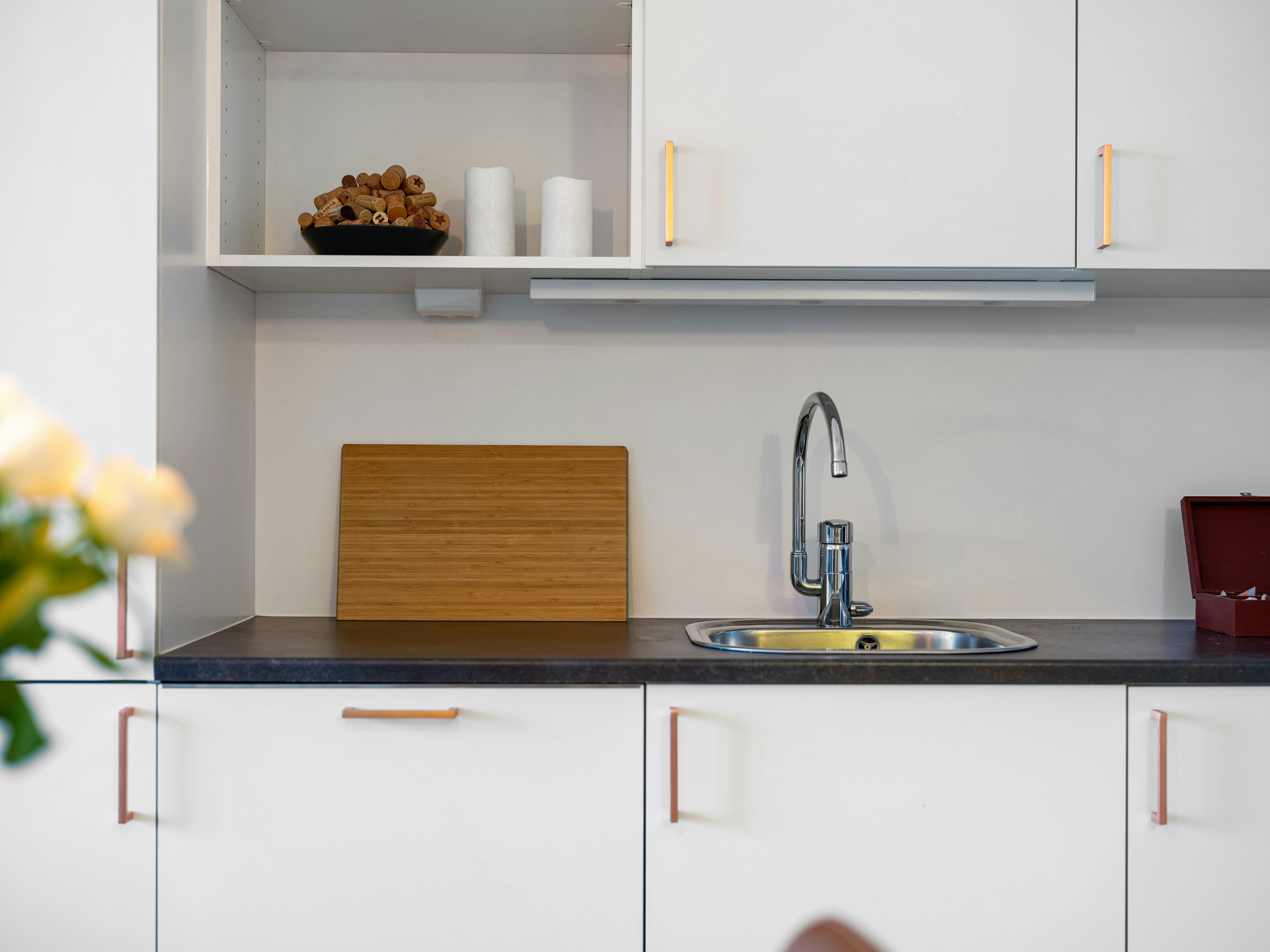
Are Vinyl Wrapped Kitchen Doors Any Good ?
May 20, 2025What Are Vinyl Wrapped Kitchen Doors?
Vinyl wrapped kitchen doors are covered kitchen cabinet doors with a thin, self-adhesive vinyl film to change their look. In actual practice, it involves using sheets of some decorative vinyl by sticking them on the surfaces of your current kitchen cupboard doors/drawers. The vinyl adheres to the shape of the door, generally with heat, to stretch along the edges, thus creating this new finish. These wraps have limitless styles (solid colours, wood grains, marble patterns, etc.), so you can attempt the appearance of costlier materials. The idea is simple: rather than painting or even replacing your doors in your kitchen, you “wrap” them in a new style.
Pros of Vinyl Wrapped Kitchen Doors
Now, let’s explore the pros and cons of vinyl kitchen wraps, but first, the pros:
Budget-Friendly Upgrade: Vinyl wrapping is significantly cheaper than buying all new cabinet doors or a complete kitchen refit. A brand-new kitchen can easily cost well into five figures, whereas wrapping your existing doors often costs only a few hundred to a couple of thousand (depending on your kitchen size). It’s a smart way to refresh your space without overspending.
Quick and Low-Mess Installation: Unlike a traditional remodel, wrapping involves no heavy construction. There’s no need to rip out units or remove all the doors, so there’s virtually no dust, noise, or debris. A professional or experienced DIYer can wrap a kitchen in as little as a day or two for a fast transformation. You can often continue using your kitchen during the process, since there’s minimal disruption.
Huge Range of Styles: Adhesive vinyl films come in hundreds of colours and textures, from realistic woodgrains and stone patterns to high-gloss solid colours and even metallic or textured effects. This means you can achieve almost any design vision. A vinyl wrap will likely suit whether you want modern matte black cabinets or a light oak timber look. You’re not limited by what a manufacturer offers in door styles, you can mix and match looks easily.
DIY-Friendly and Convenient: Applying vinyl wrap does not usually necessitate any special know-how or equipment that specialists must use. The procedure is to clean the surface, remove the film's backing, and apply it to the door. Many homeowners can do it alone as long as patience and, perhaps, even a heat gun for corners are involved.
Easy to Maintain: Vinyl-wrapped doors are easy to clean and maintain after installation. The vinyl makes a wipeable, waterproof surface that is great for kitchens. You can remove spills and grease with a damp cloth and mild detergent. Repainting or special sealants are not needed. Humidity in a kitchen will not affect good-quality vinyl films.
Cons of Vinyl Wrapped Kitchen Doors
Limited Lifespan: A common question is, How long do vinyl kitchen wraps last? Expect a quality vinyl wrap job to last around 5 to 10 years before it may need replacing. This is a good run for a cosmetic update, but it’s shorter than the decades-long lifespan of solid wood cabinetry or a factory paint finish. Eventually, the adhesive can weaken, or the vinyl may show wear, so consider wrapping it as a medium-term solution.
Possible Peeling or Bubbling: A common problem is the vinyl peeling at the edges or bubbling after some time. This is usually the case if not correctly fitted (trapped air or poor adhesion) or after going through excessive heat and steam. For example, cabinet doors above a kettle or next to an oven might see the vinyl edges lift sooner due to the heat. While high-quality films are made to be heat-resistant, they’re not invincible, prolonged high temperatures or direct sunlight can degrade the adhesive.
Repairs Require Rewrapping: Unlike painted wood, you generally can’t do a minor touch-up on vinyl if it gets damaged. If the film gets scratched or starts to peel, you can’t simply paint over it or re-glue it seamlessly. The fix is usually to remove the vinyl and apply a new piece to that door. For instance, if a section is bubbling or peeling, that entire door’s wrap will need to be replaced; it’s not really “repairable” once compromised.
Source: Unsplash
Who Is Vinyl Wrapping Right For?
Vinyl wrapped kitchen doors can be an excellent solution for a wide range of people, but they’re especially well-suited to specific situations:
Budget-Conscious Homeowners: If you want to refresh your kitchen’s look without spending a fortune, vinyl wrap is ideal. It delivers aesthetic impact for a relatively small cost, so you can stretch your renovation budget by covering existing units instead of buying new ones.
Renters and Tenants: Vinyl wraps are one of the most popular renter-friendly kitchen upgrades for good reason, as they’re non-permanent. You can personalise a bland rental kitchen with adhesive vinyl and remove it without damage, avoiding deposit disputes. It’s a clever way to get a stylish kitchen in a rental home where painting or replacing doors is prohibited.
Interior Designers & Home Stagers: Vinyl wrap offers tremendous flexibility for design professionals or home stagers. It allows you to experiment with bold colours or trendy finishes on cabinetry without permanent alteration. Designers can cost-effectively achieve high-end looks (marble, walnut, industrial concrete, etc.) to suit a client’s vision. And if tastes change, it’s easy to update again.
Final Thoughts
Vinyl wrapped kitchen doors can be a game-changer for your kitchen, offering a fast, affordable, and stylish makeover with minimal hassle. They’re not a one-size-fits-all solution, but for many homeowners and renters, they strike the perfect balance between cost and benefit, giving you a “new” kitchen look without the usual headaches.
Ready to explore this option further? Check out our blog for more kitchen door makeover ideas, browse the benefits of adhesive vinyl wrap, and view our case studies to see real-life vinyl wrap transformations. With some creativity (and the right vinyl film), you might be just a weekend away from the kitchen of your dreams!